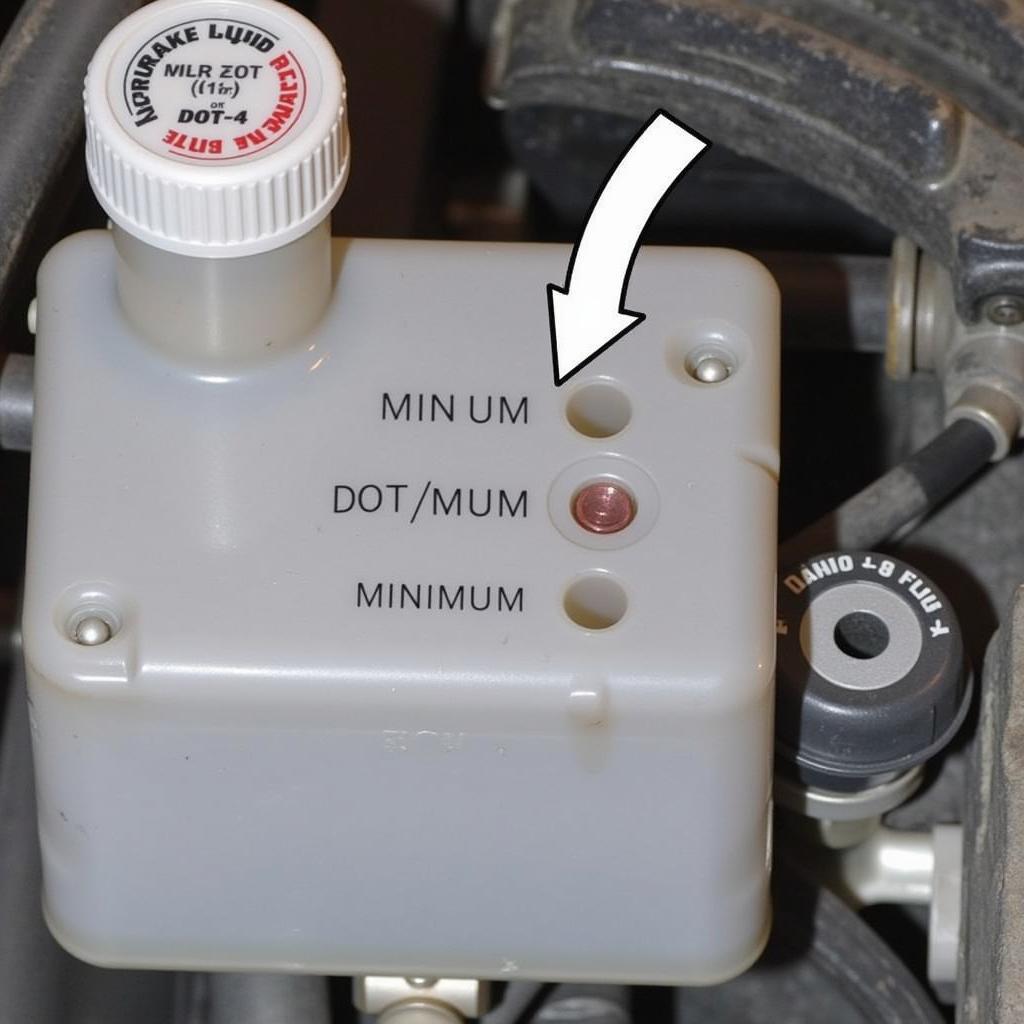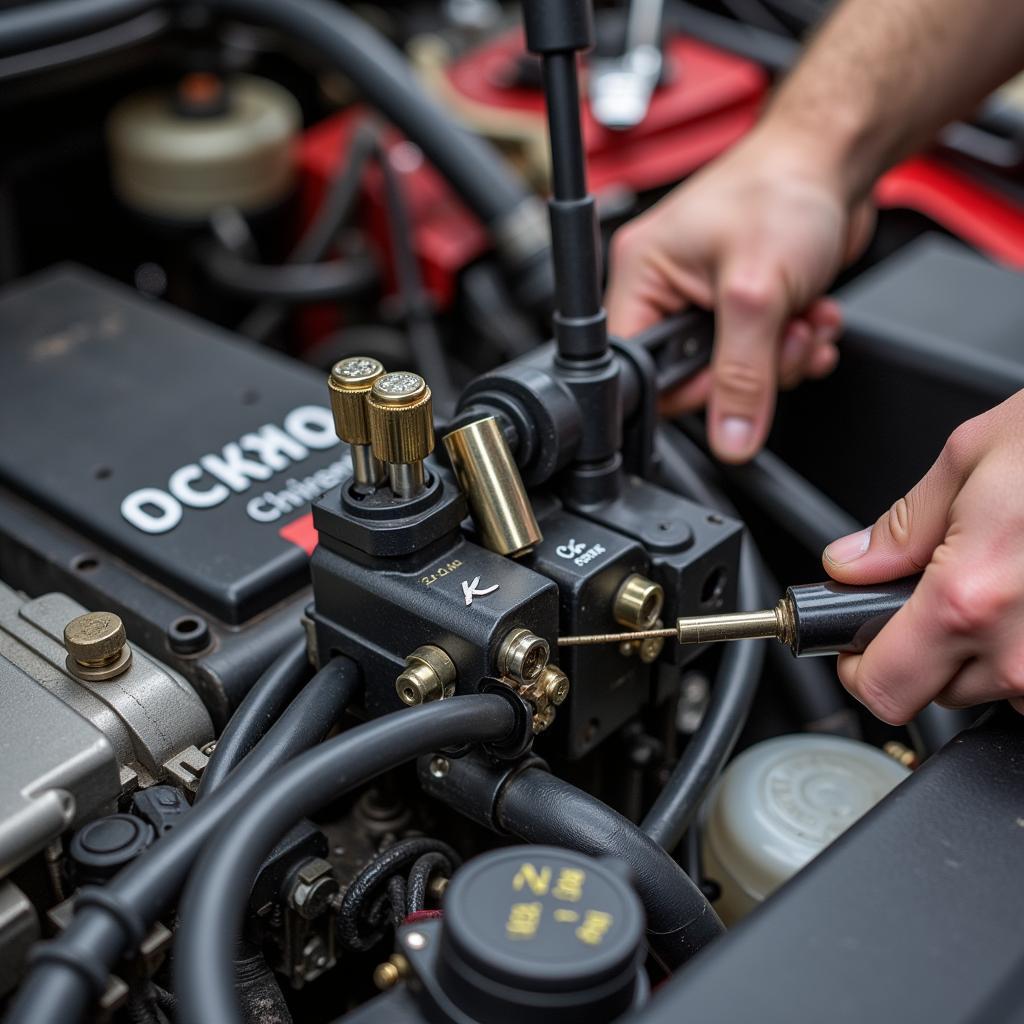The brake pad warning light on your Mercedes A Class is a crucial safety feature designed to alert you to potential issues with your braking system. Ignoring this warning light can lead to further damage, costly repairs, and compromise your safety on the road. This comprehensive guide will explore the common causes of the Mercedes A Class brake pad warning light, what to do when it illuminates, and the steps involved in resolving the issue.
Understanding Your Mercedes A Class Brake Pad Warning Light
The brake pad warning light, typically displayed as a circle with dashed brackets on either side and an exclamation mark in the center, illuminates on your dashboard for several reasons.
One of the most common reasons is worn brake pads. Brake pads are designed to wear down over time, and when they reach a certain thickness, the brake pad wear sensor triggers the warning light.
However, the warning light can also illuminate due to other factors such as:
- Wworn brake pad sensor: The brake pad wear sensor is a small wire embedded within the brake pad material. When the pad wears down, the sensor makes contact with the brake rotor, completing a circuit and illuminating the warning light.
- Faulty sensor: While less common, a faulty or damaged brake pad sensor can trigger the warning light even if your brake pads are in good condition.
- Low brake fluid: The brake pad warning light may also indicate low brake fluid levels, a serious issue that needs immediate attention.
- Electrical problems: In some cases, electrical problems within the braking system, such as a wiring issue or a faulty ABS module, can trigger the warning light.
What to Do When the Brake Pad Warning Light Comes On
If the brake pad warning light illuminates while driving your Mercedes A Class, it’s crucial to take the following steps:
- Stay calm: Don’t panic.
- Assess your braking performance: Carefully check if you notice any changes in how your brakes feel.
- Do you feel vibrations when braking?
- Does the brake pedal feel spongy or lower than usual?
- Does your car pull to one side when braking?
- Find a safe location: Safely pull over to the side of the road as soon as possible.
- Check your brake fluid: If it’s safe to do so, carefully inspect the brake fluid level in the reservoir.
- Seek professional assistance: If you notice any changes in braking performance, have low brake fluid, or are unsure about assessing the issue yourself, it’s best to contact a qualified mechanic specializing in Mercedes-Benz vehicles.
Diagnosing the Issue: Brake Pads or Something Else?
Determining the exact cause of the brake pad warning light requires a proper diagnosis.
If you are comfortable with basic car maintenance, you can try to diagnose the issue yourself by:
- Checking the brake pads visually: With the car parked on a level surface and the parking brake engaged, inspect the brake pads through the spaces between the wheel spokes. If you have less than ¼ inch of brake pad material remaining, it’s time for a replacement.
- Inspecting the brake pad sensor: The sensor is a small wire extending from the brake pad. Check for any damage or if it’s making contact with the brake rotor.
However, if you are unsure or uncomfortable performing these checks, it’s highly recommended to take your Mercedes A Class to a qualified mechanic. They will have the experience, tools, and expertise to accurately diagnose the issue and recommend the necessary repairs.
Mercedes A Class Brake Pad Replacement: What to Expect
Replacing your Mercedes A Class brake pads is a routine maintenance procedure. If you’re mechanically inclined, you can find detailed instructions in your owner’s manual or online resources.
However, if you prefer to leave it to the professionals, here’s a general overview of what to expect during a brake pad replacement:
- Inspection: The mechanic will begin by inspecting the entire braking system, including the rotors, calipers, brake lines, and fluid levels.
- Brake pad replacement: The old brake pads will be removed, and new pads compatible with your Mercedes A Class model will be installed.
- Rotor resurfacing or replacement: Depending on their condition, the brake rotors might be resurfaced or replaced.
- Brake fluid flush: It is often recommended to flush and replace the brake fluid during a brake pad replacement service.
- Testing: After the replacement, the mechanic will test the brakes to ensure they function correctly.
Resetting the Brake Pad Warning Light
After replacing the brake pads and addressing any other issues, the brake pad warning light will need to be reset. In some cases, the light may turn off automatically after a few driving cycles.
However, if the light stays on, you can try resetting it yourself by following these general steps (always refer to your owner’s manual for model-specific instructions):
- Turn the ignition to the “on” position without starting the engine.
- Press the brake pedal down firmly and hold it for 5 seconds.
- While still holding the brake pedal, turn the ignition off.
- Release the brake pedal.
If these steps don’t reset the light, you might need to use a specialized diagnostic tool.
For more information on resetting brake warning lights in various Mercedes models, you can refer to our guides on Mercedes red brake warning light and Vito brake pad warning light reset.
Preventing Premature Brake Pad Wear
To extend the lifespan of your brake pads and maintain optimal braking performance, consider the following tips:
- Avoid aggressive driving: Frequent hard braking and rapid acceleration can significantly increase brake pad wear.
- Coast when possible: Anticipate stops and coast to slow down, reducing the need for heavy braking.
- Lighten your load: Carrying excessive weight in your vehicle puts additional strain on the braking system.
- Regular maintenance: Adhere to your Mercedes A Class’s recommended maintenance schedule, which includes regular brake inspections.
Expert Insight
“Ignoring a brake pad warning light can lead to costly repairs and compromise your safety,” says master Mercedes technician, Hans Schmidt, with over 20 years of experience. “It’s crucial to address the issue promptly to ensure optimal braking performance.”
Conclusion
The brake pad warning light on your Mercedes A Class is a crucial safety feature you should never ignore. Understanding the potential causes and taking prompt action can prevent further damage, costly repairs, and ensure your safety on the road. Remember, regular maintenance and safe driving habits are essential for extending the life of your brake pads and maintaining optimal braking performance.
If you are ever unsure about diagnosing or addressing any issues with your Mercedes A Class, it’s always best to consult a qualified mechanic specializing in Mercedes-Benz vehicles.
Frequently Asked Questions
1. How long can I drive with the brake pad warning light on?
It’s not recommended to drive with the brake pad warning light on. If you must drive, do so with extreme caution and seek professional assistance as soon as possible.
2. Can I replace my Mercedes A Class brake pads myself?
If you are mechanically inclined and comfortable working on cars, you can replace the brake pads yourself. However, if you are unsure, it’s best to leave it to a qualified mechanic.
3. How often should I replace my Mercedes A Class brake pads?
The lifespan of brake pads varies depending on driving style and conditions. However, it’s generally recommended to have them inspected every 10,000-12,000 miles and replaced as needed.
4. Can worn brake pads damage my rotors?
Yes, driving with worn brake pads can severely damage the brake rotors, leading to costly repairs.
5. Why is my brake pad warning light still on after replacing the pads?
The warning light may need to be reset manually or using a diagnostic tool. In some cases, there might be an underlying issue that needs further diagnosis. For information on a related warning light, check out our article on the yellow brake fluid warning light on a 1983 Mercedes 300D. For a broader understanding of brake warning light meanings, you can refer to what does the brake warning light mean. Finally, for more information on brake wear warning lights, you can visit our page on brake wear warning light.
Remember: Your safety is paramount. If you are experiencing any issues with your braking system, don’t hesitate to seek professional assistance.


